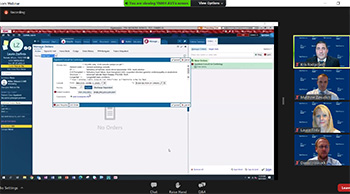Symposium examines telehealth’s past, present and future

Panelists from throughout YNHHS and Yale Medicine discussed the current and future uses of telehealth during an Oct. 13 Telehealth Symposium.
For the past 10 years, telehealth has played an increasingly important role in helping Yale New Haven Health and Yale Medicine clinicians care for patients. When COVID-19 hit, telehealth took center stage.
Between spring and early fall, YNHHS and YM clinicians conducted hundreds of thousands of video visits, phone consults and Tele-ICU interventions. Information Technology Services equipped and deployed more than 1,000 telehealth carts to medical-surgical units throughout YNHHS, and countless telehealth setups to ambulatory clinicians. ITS also increased the number of beds monitored by the health system’s InSight Tele-ICU from 72 to 200.
“We are in the midst of an exciting and important revolution in how we deliver care,” Yale New Haven Hospital President Keith Churchwell, MD, said during the keynote address at an Oct. 13 Telehealth Symposium.
More than 250 people tuned into the virtual event, held by YNHHS and YM. Representatives from both organizations discussed telehealth’s past, present and future, along with its challenges and opportunities.
Dr. Churchwell noted that telehealth’s long history began in the 1940s, when doctors in Pennsylvania used telephone lines to transmit radiology images over 24 miles. Telehealth has evolved over the years to become not just a tool for providing care, but a way to improve the health of people in communities and close the gaps in healthcare disparities, he said.
Lisa Stump, senior vice president and chief information officer at YNHHS and Yale School of Medicine, said telehealth has always offered the opportunity to use technology in new ways to improve care access, efficiency and convenience. The COVID crisis turned that opportunity into a critical need, she said, calling the rapid deployment of telehealth “COVID-19’s silver lining.”
The symposium featured panels of clinicians and staff from ITS and the joint YNHHS/Yale Medicine telehealth team, who discussed how telehealth can enhance inpatient and ambulatory care and patients’ and families’ experiences. Panelists emphasized that telehealth is designed to augment, not replace, in-person care.
Other sessions featured representatives from Payer Strategy and Patient Financial Services, who discussed active efforts to ensure that full commercial insurance, Medicare and Medicaid reimbursement for telehealth visits continues.
Future goals include finding ways to improve and leverage telehealth technology to further enhance care quality and safety.
“This is the future for all of us to make,” Dr. Churchwell said.
Recordings of all sessions and training materials will be available at the
Telehealth Training page on the intranet (in network only). Contact the ITS telehealth team at
[email protected].


